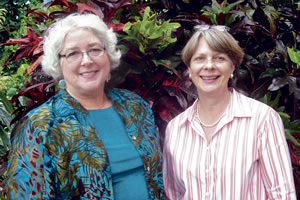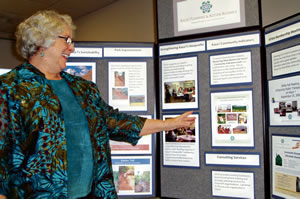Seeking New Solutions For a Better Kaua’i

Diane Zachary helped found the Kaua'i Planning & Action Alliance and today runs the citizens organization. As important as it is to study the island's problems and plan new ways to address them from sustainability to drugs she says the most important thing is to take action
A world traveler who once lived in Thailand, Diane Zachary knew she’d found a home when she first set foot in the Hawaiian Islands.
“In the course of traveling I discovered that there’s a certain kind of sense of community on islands that doesn’t exist anywhere else,” she explains.
That sense of community bringing people together is at the heart of Zachary’s role as president and CEO of Kaua’i Planning & Action Alliance. Leading the organization since its inception in 2003, Zachary is responsible for creating collaborative solutions that help resolve community issues by targeting specific active goals.
“So it’s not just planning, but it’s the action part that’s a big emphasis of what we do,” she says recently while sitting in her office that overlooks the Ha’upu mountain range in Lihu’e. Unmarried and with no children, she pours herself into her work.
Originally developed by a group of concerned citizens who wanted an organization that would bring people together to help find resolutions to their concerns, the nonprofit took several years of planning before becoming a reality. Though she initially worked from her home, Zachary has been a part of the nonprofit’s growing influence within the community since its official beginning.
Her inaugural project at KPAA was authoring the county’s first Drug Response Plan.

Diane Zachary: ‘it’s the action part that’s a big emphasis’. KPAA photo
“It essentially tried to create a roadmap for people to follow so that there was really a coordinated approach to what needed to be done,” says Zachary, a California native who graduated from San Jose State.
Taking roughly eight months to craft with the assistance of dozens of volunteers, the plan included an overview of drug use on Kaua’i, and examined prevention and enforcement as well as treatment. After working with people for five years of implementation, the plan was recently revised and has since been turned over to the county for coordination and management, and has served as a way for the county to acquire federal and state funding in support of anti-drug efforts.
It wasn’t the only project coordinated by KPAA that has had lasting effects.
The Community Indicators Report, constructed by the organization every two years, examines what matters the most to the community. The latest edition is expected to be released by the end of the month. The reports measure everything from household income to residential energy use. It even delves into topics such as canoe paddling, which helps determine how Hawaiian values are transmitted and whether the culture is being kept alive.
“This is to help determine what kind of programs are needed and how much should be spent,” says Zachary. “We also look at some things that can be done to move in a more desirable direction.”

At the Kaua‘i Planning & Action Alliance offices. Coco Zickos photo
For instance, when KPAA discovered that energy usage has been on the decline for the past three years, it conducted a telephone survey that indicated many people now utilize solar hot-water heaters. That information can assist community leaders in making more-educated decisions regarding alternative sources of power.
KPAA is a great resource for the island, says George Costa, director of the county’s Office of Economic Development.
Delving further into the energy arena, Zachary has even been involved with developing the Kaua’i Energy Sustainability Plan by coordinating and conducting several community meetings around the island. With the input of 200 community members and the consultant company SEN TECH, a plan related to harnessing more sustainable energy on the island was created.
But it wasn’t until talk about a 50-cents-a-gallon tax on gasoline to help fund non-fossil fuel-related projects that the rest of the island’s residents became more involved.
“Suddenly everyone was interested,” says Zachary with a chuckle.
After a mere suggestion presented by SENTECH, which devised the plan, a much smaller fee ended up as one of the final recommendations. Other suggestions in the plan include facilitating more renewable energy sources such as hydropower something Kaua’i Island Utility Cooperative is currently pursuing despite the protests of some residents to federal involvement.

With student panelists at the KPAA annaual meeting (from left) Angela Mones, Bronsen Hiraoka, Natasha Abadilla, Nalu Thain and Sierra Blackford. KPAA photo
“I support hydro where it’s appropriate and where it goes by the kind of criteria that the KIUC board said, related to not impacting recreation and aqua life,” says Zachary.
While hydro may be currently stalled, other resources such as solar energy are gaining momentum.
Several photovoltaic systems are in development while others, like the Kapaa Solar farm, are already powering some 300 homes.
“Suddenly, there it was,” says Zachary about how quickly that particularly “miraculous” project was cultivated. “What the plan tried to do was talk about how the county in particular could help encourage and, in some cases, provide incentives or funding for projects to get them moving forward more quickly.”
The recession did put a damper on several projects, as their funding was either delayed or evaporated. Nonetheless, there are various projects under way that will be “exciting,” she says, refusing to divulge what some of those might be.
“There are a number of things happening that were spurred, at least in part, by that plan,” she says. “You would be shocked and amazed and pleased at all of the things that are happening.”

With assistant Rayne Regush. Coco Zickos photos
Something that can be confirmed is funding by the county to build charging stations for electric vehicles at six of its facilities.
“The whole idea about moving away from gasoline to electric cars or hybrid cars, some kind of alternative transportation to the typical fossil fuel car, was certainly a part of that plan,” says Zachary.
Prior to moving to Kaua’i in 2003, Zachary lived on Maui and was employed by Maui Community College, where she worked on special ventures. She not only started the institute’s Small Business Development Center, she also originated a visitor industry training and economic development program.
Her inaugural project was to develop the state’s first distance-education program, using microwave signals to link students on Lana’i, Molokai and Maui.
“At the time it was kind of revolutionary,” she says.
After working for 10 years at the college, Zachary began her own nonprofit, Maui Pacific Center, which had many similarities to KPAA.
“It gave me a lot of experience working with a wide variety of people and really understanding the value of cross-sector approaches to issues,” she says of bringing together government entities, businesses and nonprofits with a variety of views. “The result is so much richer and can be accepted by more people.”

Zachary is all about organization
Zachary plans to promote an even more collaborative impact at KPAA. An upcoming project is aimed at developing strong, healthy youths on Kaua’i.
“It’s cradle to career, how you develop young people to have a strong sense of self self-esteem and strong character,” she says.
Zachary also is seeking ways to help Kaua’i’s homeless population find safe shelter at night.
“There’s no place for them to go,” she says, suggesting options such as designated public parking areas.
The Sustainability Action Team is yet another collaborative effort directed by Zachary, where leaders from island organizations work cohesively to help county and other sustainable initiatives progress.
“Living on one of the most secluded land masses on planet Earth, Kaua’i residents need to view life and our existence, with ‘sustainability’ being a key word in the discussion,” says Costa of the new team.
Projects are always evolving at KPAA, and Zachary doesn’t plan to slow them down anytime in the near future.



